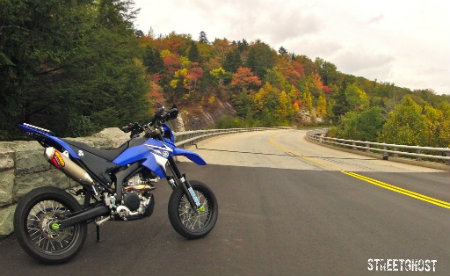I just installed a Scotts on my WR and I thought I would take a few pictures and document things.
I ordered my Scotts kit form Renazco Racing and I already have this damper on my F800GS. I really like the quality of this damper as well as its adjustability. It makes a big difference in sand, rocks, and overall fatigue reduction.
Start off by putting the bike up on a stand and then blocking the front wheel. This will make things easier when you loosen up the triple.

Next up you need to remove the upper bar clamps. I am using the Highway Dirt Bike guards so here I am removing the top plate. I ended up with a new top plate that would allow me to reposition my Powerlet outlet back behind the damper.

Then remove the fork clamp pinch bolts.

Lift the bars out of the way and loosen up the main triple clamp nut. This requires a 27 mm socket and a fair bit of force.

At this point you need to remove the lower bar perches. My Highway Dirt Bike perches have an allen bolt that passes down through the top with a nut on the bottom. I found it easier to grasp by sliding the upper triple free from the forks. I believe the OEM perches have a bolt that comes up form the bottom. In this case you may want to leave the triple at least partly on the forks so you can have something to turn against if the perches start to spin.

You can now install the Scotts lower SUB mount. This is attached to the triple by the Scotts bolts that pass up through the bottom of the triple into the SUB mount. It is important to make sure you use the included aluminum spacers shown below (yellow zip tie is pointing them out), or the damper wont clear the top of the triple. Note that this picture was taken later in my install but it shows the position of the spacers. The bolts have lock washers and I recommend also using lock tight.

With everything out of the way you will be looking at the castle nuts.

Remove the lock tab, jam castle nut , and rubber washer. These items will not go back on. I didn't have the special socket for the castle nut. The Scotts instructions suggest using a screwdriver in the notches to loosen / tighten these nuts. I just carefully used some channel locks.

Remove the lower castle nut just over the head bearings.

Replace this with the special nut that Scotts supplies. This is a 32mm square nut. The recommendation from Yamaha is 38 Nm, loosen fully, then retighten to 7 Nm. I couldn't figure out a way to measure this exact torque so there is some feel involved. You want the head bearings secure but not so tight they impede motion of the bars side to side.

Remove the front gas tank bolt.

Set the Scotts frame bracket over the stem then lift up slightly on the gas tank to allow you to slip the front edge of the frame bracket into position.

Make sure the frame bracket is fully seated in position over the stem and under the tank edge.

Replace the front gas tank bolt (10 Nm) and then put the stock castle nut back over the Scotts frame bracket. According to Scotts, this should be snug then 1/8 turn more. If you over tighten this you will add tension to the bearings. Again I used channel locks.

Slip the top triple back into position and secure it with the main nut. 27mm tightened to 120 Nm. I straddled the front wheel to keep it from rotating off the blocks when I torqued this down.

Fork pinch bolts back in position. 10mm tightened to 23 Nm.

You can set the bars back into position and now is a good time to check all the cables. The Scotts will raise up your bars a bit and you need to make sure you have room when the bars are turned fully side to side. I had to re-route my ignition / starter button mount and cable.
Grease the floating tower pin and slip it into position. This pin has a collar that can be adjusted to get the best height. You will see this better with the damper down on the SUB mount.

Align everything and place the damper down on the SUB mount. Make sure that the tower pin doesn't hit the bottom of the damper. Secure the damper to the SUB mount with the supplied bolts.

Check your clearances. The tower pin should be roughly in the middle of its range.

This shows why you need the spacers under the SUB mount so the bottom of the damper doesn't hit the top of the stem.

Bolt your bars / top plate back on and you are good to go.


Hopefully someone will find this useful.
